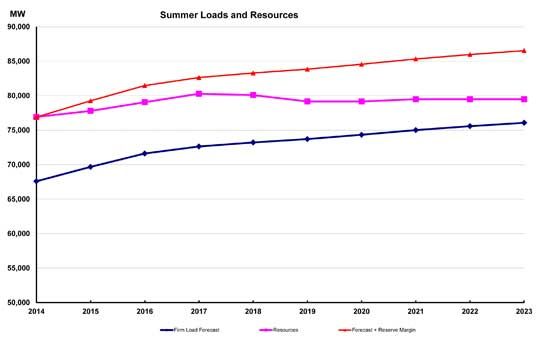The Electricity Reliability Council of Texas (ERCOT), which manages Texas’s grid, will raise the system-wide offer cap (SWOC) to $9,000 per megawatt-hour in 2015. For the summer of 2013, the SWOC will be $5,000, up from $2,500 just two years ago. Most other areas of the country have a far lower market cap, between $1,000 to $2,500. (For the math and methodology of the ERCOT SWOC, click here [.doc file].)
The price spike is meant to encourage new generation as Texas’ capacity needs get dangerously close to its reserve margin. But the high prices could also impact demand response, which is badly needed in the Lone Star State in summer. The SWOC, which is essentially a price cap during scarcity conditions, usually only kicks in during the very hottest days of summer when generation is strained to keep up with the high demand.

(Key to graph above. Blue: Firm Load Forecast; Pink: Resources; Red: Forecast + Reserve Margin).
Demand response is growing at about 10 percent a year in ERCOT, but unlike PJM Interconnection, which has robust demand response offerings, there is no forward capacity auction. ERCOT, however, is toying with the idea of a forward capacity auction. ERCOT is also considering opening up ancillary services to demand response, which is an active market in PJM.
Large commercial and industrial customers may want to increase their participation in the demand response programs that are offered through utilities and ERCOT to hedge against being exposed to the potential high prices during the hottest days of summer. But to really curb peak, Texas needs the participation of everyone. The price signal alone does not provide ERCOT with a reliable source of load reduction,” Frank Lacey, VP of regulatory and market strategy at Comverge, recently wrote on Greentech Media.
To hedge against the high prices, retail electric providers may build more aggressive (and attractive) time-of-use and demand response programs to offer customers. Some of the large retailers like TXU and Reliant already have some time-based offerings, but there’s no clear information on how much peak load relief they’re delivering.
For the first time in ERCOT, there will be a “weather-sensitive load” pilot program in 2013 to allow residential and small commercial to take part in the grid operator’s demand response program. The pilot is capped at 30 megawatts, but it will likely be smaller, according to Paul Wattles, supervisor of demand response for ERCOT.
There are also some moves afoot in the Texas Senate to boost demand response participation. Senate Bill (SB) 1351 would require ERCOT to allow customers to participate in all competitive energy markets, while Senate Bill (SB) 1280 would require ERCOT to have enough demand response on hand to meet reliability needs if traditional generation cannot meet the demands.
ERCOT would welcome active participation from millions of residents. “If there’s going to be a lot of movement,” said Wattles, “it’s going to be in retail.”



